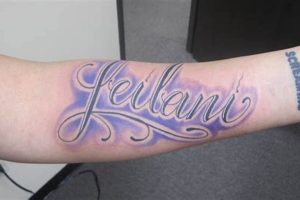A tattoo featuring the word “Namaste,” often accompanied by visual elements such as the traditional hand gesture (Anjali Mudra), lotus flowers, mandalas, or chakra symbols, represents a respectful greeting or farewell, acknowledging the divine in oneself and others. Such designs can range from simple script to intricate artwork incorporating various symbolic imagery from Indian spiritual traditions.
Choosing this type of body art often signifies a connection to yoga, meditation, or broader spiritual practices, serving as a personal reminder of inner peace, mindfulness, and reverence for life. The historical and cultural significance of the Sanskrit word adds depth and meaning, reflecting a growing interest in Eastern philosophies and their emphasis on unity and interconnectedness. These designs can be a powerful expression of personal beliefs and a commitment to a mindful lifestyle.
Exploring design options, placement considerations, and the artistic styles best suited for these tattoos provides a deeper understanding of their potential for meaningful self-expression.
Tips for Choosing a Namaste-Inspired Tattoo
Careful consideration of design elements, placement, and artistic style ensures a meaningful and aesthetically pleasing tattoo.
Tip 1: Research Symbolism: Thorough research into the various symbols associated with “Namaste,” such as the Anjali Mudra, lotus flowers, and chakras, allows for informed design choices that resonate with personal beliefs.
Tip 2: Consider Placement: Placement should reflect the desired level of visibility and complement the body’s natural contours. Areas like the forearm, wrist, back, or behind the ear offer varying degrees of prominence.
Tip 3: Choose a Reputable Artist: Selecting a skilled tattoo artist experienced in fine linework, script, or the specific style desired is crucial for a high-quality, long-lasting tattoo.
Tip 4: Explore Different Fonts: The chosen font for the word “Namaste” can significantly impact the overall aesthetic. Consider Sanskrit scripts or elegant, flowing fonts that complement the accompanying imagery.
Tip 5: Reflect on Personal Meaning: Infusing the design with personal elements adds depth and significance. Consider incorporating birthdates, meaningful quotes, or symbols that represent individual journeys or values.
Tip 6: Size and Detail: The level of detail and intricacy should be proportionate to the chosen placement and size. Smaller tattoos may require simpler designs, while larger areas allow for more elaborate artwork.
Tip 7: Plan for Long-Term Care: Proper aftercare ensures the tattoo heals well and retains its vibrancy. Follow the artist’s instructions diligently and protect the tattoo from sun exposure.
Thoughtful planning and attention to these details results in a beautiful and meaningful representation of one’s spiritual journey.
By considering these tips, individuals can create a lasting tribute to the principles of peace, respect, and interconnectedness.
1. Placement
Placement significantly impacts the visual presentation and personal meaning of a “Namaste” tattoo. The chosen location on the body influences how the design interacts with natural contours and affects its visibility. A wrist placement allows for subtle display and serves as a personal reminder, while a placement on the back offers a larger canvas for intricate designs and increased privacy. Placement also interacts with the tattoo’s symbolism; for instance, a heart chakra tattoo placed near the chest amplifies its connection to love and compassion. Similarly, a “Namaste” tattoo placed on the hands or forearms, areas prominently displayed during yoga or meditation, reinforces the connection to these practices.
Consideration of clothing and lifestyle further informs placement decisions. Individuals who frequently wear professional attire may opt for locations easily concealed. The size and complexity of the design also influence placement; intricate designs benefit from larger areas like the back or thigh, while smaller, simpler designs suit the wrist, ankle, or behind the ear. The curvature of the body provides another consideration, as certain designs flow more naturally with specific body parts. A flowing script, for instance, may complement the curve of a forearm or ribcage more harmoniously than a flat surface.
Strategic placement elevates the “Namaste” tattoo beyond mere aesthetics, integrating it into the wearer’s physical presence and spiritual journey. Careful consideration of visibility, personal meaning, and practical factors ensures the chosen placement enhances the tattoo’s overall impact and enduring significance.
2. Symbolism
Symbolism plays a crucial role in enriching the meaning and depth of “Namaste” tattoos. The word itself, derived from Sanskrit, carries inherent spiritual weight, signifying a respectful salutation acknowledging the divine within. This intrinsic symbolism extends to the visual elements often incorporated into these tattoo designs. The Anjali Mudra, the traditional hand gesture associated with “Namaste,” represents unity and connection. The lotus flower, frequently depicted alongside “Namaste,” symbolizes purity, enlightenment, and spiritual awakening. Mandalas, with their intricate geometric patterns, evoke the universe’s interconnectedness and the cyclical nature of life. Chakra symbols, representing energy centers within the body, add another layer of symbolic meaning related to balance and well-being. Incorporating these symbols transforms the tattoo into a visual representation of one’s spiritual journey and values.
The choice of specific symbols and their arrangement can further personalize the tattoo’s meaning. For example, a “Namaste” tattoo combined with a Hamsa hand might represent protection and blessings, while the addition of unalome symbols could signify the path to enlightenment. A depiction of the seven chakras aligned along the spine could represent a commitment to spiritual growth and balance. These choices create a unique narrative, allowing the tattoo to serve as a personal affirmation of one’s beliefs and aspirations. The selection of specific symbols becomes a powerful tool for conveying nuanced meanings and expressing individual connections to the underlying philosophies. A tattoo featuring a blooming lotus, for instance, can signify growth and overcoming challenges, whereas a closed lotus bud might symbolize potential yet to be realized.
Understanding the symbolism embedded within “Namaste” tattoos allows for a more informed and meaningful design process. It empowers individuals to create body art that resonates deeply with their personal beliefs and spiritual journeys. By carefully selecting and combining symbolic elements, the tattoo transcends mere aesthetics, becoming a powerful reminder of inner peace, reverence for life, and the interconnectedness of all beings. This conscious integration of symbolic elements ensures the tattoo remains a source of personal meaning and inspiration.
3. Font choice
Font choice significantly influences the overall aesthetic and cultural authenticity of “Namaste” tattoos. Typography conveys not only the literal word but also subtle nuances of style and meaning. Careful selection ensures the chosen font harmonizes with the accompanying imagery and accurately reflects the spiritual depth of the concept.
- Traditional Sanskrit Scripts:
Utilizing traditional Sanskrit scripts, such as Devanagari or Bengali, adds authenticity and reverence. These scripts imbue the tattoo with a deeper connection to the word’s origins and cultural context. However, legibility and accurate representation require careful research and collaboration with a skilled artist familiar with these scripts. Incorrect or stylized interpretations can detract from the intended meaning and cultural respect.
- Modern Calligraphy and Script Fonts:
Modern calligraphy and script fonts offer a balance between elegance and readability. These styles often evoke a sense of flow and grace, complementing the spiritual themes associated with “Namaste.” Variations in stroke weight and ornamentation allow for personalization while maintaining a contemporary aesthetic. However, over-stylization can detract from the word’s sacred meaning, requiring careful consideration of the font’s overall tone and visual impact.
- Serif and Sans-Serif Fonts:
Simple serif or sans-serif fonts can convey a minimalist and modern approach. These fonts prioritize clarity and readability, particularly for smaller tattoos or those incorporating minimal accompanying imagery. While these choices offer versatility, they may lack the visual richness and cultural connection of script fonts. Careful pairing with appropriate imagery becomes crucial to avoid a generic or simplistic appearance.
- Decorative and Ornate Fonts:
Highly decorative or ornate fonts can add visual interest but risk overshadowing the word’s meaning. Intricate details and embellishments can detract from the tattoo’s spiritual significance if not carefully balanced with other design elements. Overly stylized fonts can also compromise readability, particularly as the tattoo ages. Careful consideration of long-term visual impact and cultural appropriateness is paramount.
Ultimately, font choice should enhance, not detract from, the overall message and aesthetic of the “Namaste” tattoo. The chosen typography should complement the accompanying imagery and reflect the wearer’s personal style while respecting the cultural and spiritual significance of the word. Balancing aesthetics with authenticity ensures the tattoo remains a meaningful and visually appealing representation of one’s beliefs.
4. Size and Detail
Size and detail are crucial considerations in “Namaste” tattoo design, significantly impacting the visual impact, readability, and longevity of the chosen artwork. Careful planning ensures the design elements, from intricate mandalas to simple script, render effectively and age gracefully. The chosen size directly influences the level of detail achievable, requiring a balance between artistic vision and practical limitations.
- Small-Scale Designs:
Smaller tattoos, often placed on the wrist, ankle, or behind the ear, necessitate simplified designs. Intricate details may lose clarity or merge together over time. Clean lines, minimalist imagery, and simple script maintain visual appeal and legibility. These designs often prioritize the word “Namaste” itself or a single, symbolic image, such as a small lotus flower or the Anjali Mudra hand gesture. The limited size encourages a focus on essential elements, creating a subtle yet powerful statement.
- Large-Scale Designs:
Larger canvases, like the back, chest, or thigh, offer opportunities for intricate detail and complex compositions. Elaborate mandalas, detailed depictions of deities, or flowing scenes incorporating multiple symbols become feasible. Larger sizes allow for greater nuance in shading, color gradients, and linework, creating visually stunning pieces. These expansive designs often serve as a focal point, showcasing the wearer’s dedication to the spiritual principles represented.
- Impact of Detail on Longevity:
The level of detail directly impacts a tattoo’s longevity. Fine lines and closely spaced elements are more susceptible to fading and blurring over time, especially with sun exposure. Larger, bolder designs tend to age more gracefully. Choosing an appropriate level of detail for the chosen size ensures the tattoo remains visually appealing for years to come. Consultation with a skilled tattoo artist is crucial to determine the optimal balance between detail and longevity.
- Proportion and Placement:
The size and detail of the tattoo should harmonize with its placement on the body. A large, intricate design might overwhelm a small area like the wrist, while a small, simple design could appear lost on a larger area like the back. Proportionality ensures the design complements the body’s natural contours and remains aesthetically balanced. Placement also influences visibility and personal meaning, further emphasizing the importance of considering size and detail in relation to the chosen location.
The interplay of size and detail is fundamental to creating a “Namaste” tattoo that effectively embodies the wearer’s spiritual intentions. Careful consideration of these factors ensures the final result is not only visually appealing but also a lasting tribute to the principles of peace, respect, and interconnectedness. Balancing artistic vision with practical considerations guarantees a tattoo that remains meaningful and aesthetically pleasing throughout its lifetime.
5. Artistic Style
Artistic style significantly impacts the visual representation and overall meaning of “Namaste” tattoos. The chosen style dictates the aesthetic tone, influencing how the core message of peace and reverence is conveyed. Different artistic styles offer unique approaches to depicting the word “Namaste” and its accompanying symbolism. A minimalist style, characterized by clean lines and simple forms, emphasizes clarity and symbolic representation, focusing on the essential elements. Geometric patterns, often inspired by mandalas or sacred geometry, create intricate and visually captivating designs that reflect the interconnectedness of all things. Watercolor styles, with their flowing gradients and vibrant hues, evoke a sense of fluidity and ethereal beauty, aligning with the spiritual themes of transcendence and inner peace. Realism, focusing on detailed and lifelike depictions, can be employed to create powerful portraits of deities or intricate renderings of symbolic objects, adding depth and narrative to the tattoo.
Consider a “Namaste” tattoo rendered in a traditional Japanese style. Bold lines, vibrant colors, and stylized imagery create a visually striking design that pays homage to Eastern artistic traditions while conveying a sense of reverence. In contrast, a dotwork “Namaste” tattoo, composed entirely of meticulously placed dots, evokes a sense of texture and depth, representing the intricate nature of the spiritual journey. A tribal-inspired design, with its bold patterns and symbolic motifs, could connect the wearer to ancestral traditions while emphasizing the universal themes of respect and interconnectedness. Selecting an artistic style that resonates with personal aesthetics and spiritual understanding enhances the tattoo’s overall impact, transforming it into a powerful expression of individual beliefs.
Understanding the interplay between artistic style and symbolic representation allows for informed decision-making during the design process. Choosing a style that aligns with the intended message and personal aesthetic preferences ensures the “Namaste” tattoo remains a meaningful and visually compelling reflection of one’s spiritual journey. This deliberate choice elevates the tattoo beyond mere decoration, transforming it into a powerful symbol of inner peace, reverence, and the interconnectedness of all beings.
6. Personalization
Personalization imbues “Namaste” tattoos with individual significance, transforming them from generic symbols into unique expressions of personal beliefs and experiences. While the word “Namaste” and its associated imagery hold inherent meaning, personalization adds a layer of depth and authenticity, reflecting the wearer’s specific spiritual journey. Incorporating elements relevant to one’s life experiences, passions, or values enhances the tattoo’s resonance and transforms it into a powerful personal talisman. This customization might manifest through the integration of birthdates, meaningful quotes, or symbols representing personal milestones or challenges overcome.
Consider an individual whose spiritual journey is deeply intertwined with their love for nature. Incorporating elements like mountains, trees, or specific animals alongside the word “Namaste” creates a personalized narrative, reflecting the interconnectedness they perceive between their spiritual practice and the natural world. Another individual might choose to integrate a symbol representing a loved one who has passed, intertwining their memory with the concept of reverence and spiritual connection. A musician could incorporate musical notes or instruments into their design, linking their passion with their spiritual expression. These personalized additions infuse the tattoo with deeper meaning, ensuring its relevance to the individual’s unique life story. A yoga enthusiast might personalize their “Namaste” tattoo by adding a visual representation of their favorite asana or a quote from a revered yogic text. Such additions create a powerful visual reminder of their dedication to the practice and its underlying philosophy.
Personalization ensures the “Namaste” tattoo remains a source of individual strength and inspiration, reflecting not only a universal message of peace and respect but also a deeply personal narrative. This customization process transforms the tattoo into a powerful reminder of one’s unique journey, values, and aspirations, strengthening the connection between the individual and the spiritual principles embodied by “Namaste.” It is through personalization that the tattoo truly becomes a unique expression of the wearer’s spiritual identity.
7. Cultural Sensitivity
Cultural sensitivity is paramount when considering “Namaste” tattoo ideas. “Namaste,” derived from Sanskrit, carries deep spiritual and cultural significance within Hinduism and other Indian traditions. Appropriating this sacred greeting without understanding its context risks trivializing its meaning and causing offense. Respectful engagement requires acknowledging “Namaste” as more than a trendy phrase; it represents a profound expression of respect and recognition of the divine within oneself and others. Thoughtful consideration of this cultural context is essential to avoid misappropriation and ensure the tattoo remains a respectful homage rather than a superficial aesthetic choice. For instance, depicting “Namaste” alongside flippant or culturally unrelated imagery undermines its spiritual significance and demonstrates a lack of respect for its origins. Similarly, altering the traditional Anjali Mudra hand gesture or distorting Sanskrit script can be perceived as disrespectful.
Demonstrating cultural sensitivity involves thorough research and mindful design choices. Consulting with individuals knowledgeable about Indian culture and spiritual traditions can provide valuable insights and ensure respectful representation. Choosing appropriate accompanying imagery, such as traditional symbols like the lotus flower or Om, further enhances the tattoo’s authenticity and avoids misappropriation. Prioritizing respectful representation over mere aesthetics demonstrates genuine appreciation for the cultural significance of “Namaste.” For example, researching the specific meaning and symbolism of different mudras before incorporating them into a tattoo design demonstrates respect for their cultural context. Similarly, understanding the significance of colors within Hinduism can inform color choices, ensuring they align with traditional interpretations and avoid unintended misrepresentations.
Respectful engagement with the cultural context of “Namaste” ensures the tattoo remains a meaningful expression of spiritual reverence. It transforms a potentially superficial aesthetic choice into a powerful symbol of respect, understanding, and appreciation for the rich traditions from which it originates. Failing to prioritize cultural sensitivity risks perpetuating harmful stereotypes and diminishing the profound significance of this sacred greeting. Ultimately, demonstrating cultural sensitivity honors the spiritual depth of “Namaste” and ensures its respectful representation within the context of body art.
Frequently Asked Questions
Addressing common inquiries regarding “Namaste” tattoos clarifies their significance and promotes respectful representation.
Question 1: Is it culturally appropriate to get a “Namaste” tattoo if one is not of Indian heritage?
Appreciation for the cultural and spiritual significance of “Namaste” transcends ethnicity. Respectful representation, demonstrated through informed design choices and understanding of the word’s meaning, is key. Superficial or disrespectful depictions, however, can constitute cultural appropriation.
Question 2: What is the best placement for a “Namaste” tattoo?
Optimal placement depends on personal preference, desired visibility, and design complexity. The wrist, forearm, back, and behind the ear are popular choices, each offering unique advantages. Placement should complement the design and the body’s natural contours.
Question 3: What are common symbols used with “Namaste” tattoos?
The Anjali Mudra hand gesture, lotus flower, mandalas, and chakra symbols frequently accompany “Namaste” tattoos, each adding layers of symbolic meaning related to peace, reverence, and spiritual growth. Thorough research into the symbolism of chosen elements ensures appropriate representation.
Question 4: How can one ensure their “Namaste” tattoo is not offensive?
Thorough research, consultation with knowledgeable individuals, and respectful design choices are essential. Avoiding flippant depictions, caricatures, or misrepresentations of sacred symbols demonstrates cultural sensitivity. Prioritizing respectful representation over mere aesthetics is crucial.
Question 5: What font styles are appropriate for “Namaste” tattoos?
Traditional Sanskrit scripts, elegant calligraphy fonts, and simple serif or sans-serif fonts can all be appropriate. The chosen font should complement the overall design and reflect the word’s spiritual depth, avoiding overly stylized or culturally insensitive depictions.
Question 6: Does the size of a “Namaste” tattoo affect its meaning?
Size influences design complexity and placement options but does not inherently alter the core meaning. Larger tattoos allow for more intricate detail, while smaller designs prioritize simplicity and subtlety. Proportionality to the chosen body part and the level of detail remain important considerations.
Careful consideration of these questions ensures a respectful and meaningful representation of “Namaste” in tattoo form.
Exploring various design galleries provides further inspiration and guidance for creating a personalized “Namaste” tattoo.
Namaste Tattoo Ideas
Exploring “Namaste” tattoo ideas requires careful consideration of symbolism, placement, artistic style, and cultural sensitivity. From minimalist designs focusing on the Sanskrit script to intricate depictions incorporating traditional imagery, these tattoos offer a powerful means of expressing personal beliefs and spiritual journeys. Placement choices range from discreet locations like the wrist to larger canvases such as the back, each influencing visibility and personal meaning. Font selection, ranging from traditional Sanskrit scripts to modern calligraphy, further impacts the tattoo’s aesthetic and cultural authenticity. The interplay of size and detail determines the level of intricacy achievable, requiring careful consideration of longevity and visual impact.
Ultimately, a “Namaste” tattoo represents more than a mere aesthetic choice; it embodies a commitment to the principles of peace, respect, and interconnectedness. Thoughtful design choices, informed by research and cultural sensitivity, transform these tattoos into powerful symbols of personal growth and spiritual reverence. Through mindful consideration of these elements, individuals can create lasting tributes to the profound meaning encapsulated within “Namaste.”







